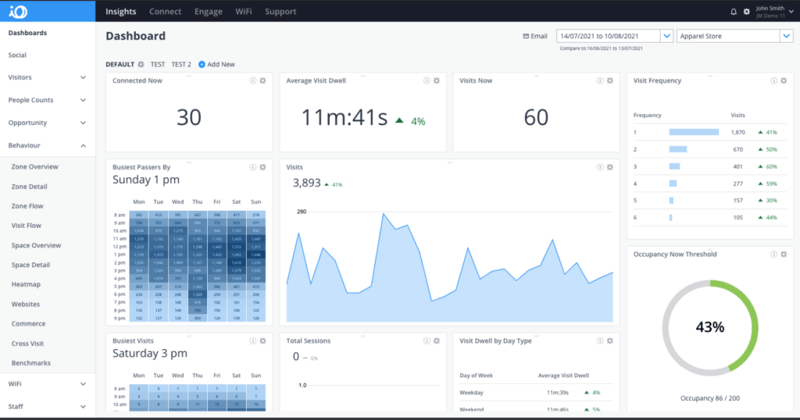Leveraging Building Occupancy Data To Increase Energy Efficiency
.jpg?length=1200&name=blog-header-1200x600%20(16).jpg)
Climate change is one of the main challenges the world faces today, according to the IPCC. Wildfires, powerful hurricanes, tropical storms, floods, droughts, and temperature extremes are now commonplace. Without coordinated action, temperatures could rise over 3 degrees Celsius within this century.
The good news is that we can turn it around. The U.S. government has pledged to reduce greenhouse gas emissions nationally by at least 50% by 2030. In the commercial sector, BlackRock—the world’s largest asset manager—hopes to lead by example by making climate change central to its investment strategy. This is because climate change is posed to have an increasingly negative impact on the world’s economy, including BlackRock’s investments.
Increasing Energy Efficiency for Buildings
As buildings consume about 40% of global energy, they are the largest contributor to global greenhouse gas emissions, according to UNEP. Reducing energy use in commercial buildings would have a tremendous impact on our environment and energy security.
As an analytics company focused on building utilisation, Beonic is privileged to be able to contribute to a solution. Beonic are experts at helping building operators understand occupancy trends by analysing behavioural patterns. Simply by calculating building occupancy accurately, owners and property managers are laying the groundwork to make informed and actionable decisions in optimizing their energy usage.
How Beonic Helps You Understand Building Occupancy Data
You cannot optimise energy costs and cut down on emissions until you understand how your building systems consume energy and occupants behave. Beonic helps you understand two correlating data categories:
- Contextual (lighting, HVAC/thermostat, weather, etc.)
- Behavioural (movement, occupancy, and dwell time)
By understanding how context impacts behaviour, you can optimise an environment. In terms of your building, you’ll be able to reduce energy consumption and costs and increase occupant comfort.

Calculating Building Occupancy To Improve Energy Efficiency
Beonic measures occupancy using sources such as CCTV, BLE (Bluetooth Low Energy), LiDAR (Light Detection and Ranging), people counters, and WiFi. A recent study found that WiFi is a very effective means of calculating building occupancy and has one major advantage: it does not require modifications to the existing building infrastructure that would potentially increase energy consumption. Understanding occupant behaviour is a critical component in building energy conservation.
Beonic’s intelligent platform gives you a holistic view of your building so you can automate your building systems in particular areas and respond and adjust them in real time. When you understand your building’s occupancy data, you can use those insights to save energy.
For example, when a small space is occupied by many people, occupancy sensors can direct HVAC systems to lower the room temperature. Research indicates that 20% of global greenhouse gas emissions originate from buildings and HVAC systems are responsible for over 50% of those emissions. When you optimise your building systems based on occupant behaviour, you will help lower greenhouse gas emissions.
Understanding Your Building’s Historical Patterns
The Beonic platform can track historical data trends so you can understand occupant behaviour and overall energy consumption patterns. This is incredibly important because it helps you better plan and automate your building systems for the future. Automation also helps eliminate human error as it does not rely on occupants to turn down thermostats or shut off lights.
Data shows that building energy consumption can be reduced by more than one third when occupant activity is examined using various sensors. Occupants often leave lights and equipment on when exiting a room, which continues to consume energy during non-working hours. This illustrates how occupancy data monitoring can work in tandem with energy automation to significantly reduce energy waste.
For example, you can use historical data trends to adjust the HVAC and lighting settings to accommodate occupancy levels—like tuning your building to use less energy during unoccupied times. In addition, if trends determine that the likelihood of occupants in a space during a particular time is low—even during a building’s occupied hours—then you can reduce HVAC and lighting appropriately.
A Simple Solution Can Make a Sizable Impact
Data is a powerful tool to help you understand the relationship between occupancy levels and your building systems. As a building owner, you have the privilege to contribute to a global solution by lowering energy consumption through calculating building occupancy effectively and acting on relevant contextual and behavioural data. Insights from real-time and historical building systems and occupancy data can empower you to make informed and actionable decisions to help reduce your building’s energy use.
Make Your Building More Energy-Efficient
Beonic recently partnered with BrainBox AI, the leader in HVAC AI technology for commercial and corporate real estate, to give our customers the ability to rapidly optimise their occupancy data to drive significant energy savings. BrainBox AI’s solution enables the HVAC system in a building to operate autonomously and in real time, resulting in a decrease in total energy costs of up to 25%, a 20–40% reduction in carbon footprint, and a 60% increase in occupant comfort.
Are you ready to make your building more energy-efficient? Request a demo today to learn how Beonic can help you drive sustainability by calculating building occupancy to decrease your building’s energy usage.
